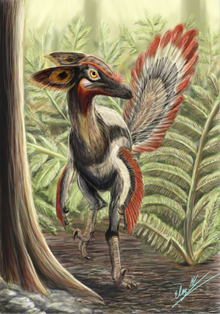Philovenator
|
Philovenator Temporal range: Late Cretaceous, 75 Ma |
|
|---|---|
 |
|
| Philovenator curriei life restoration. | |
| Scientific classification | |
| Kingdom: | Animalia |
| Phylum: | Chordata |
| Class: | Reptilia |
| Clade: | Dinosauria |
| Order: | Saurischia |
| Suborder: | Theropoda |
| Family: | †Troodontidae |
| Genus: |
†Philovenator Xu et al., 2012 |
| Species: | †P. curriei |
| Binomial name | |
|
Philovenator curriei Xu et al., 2012 |
|
Philovenator (literally meaning "love hunter") is an extinct genus of troodontid paravian dinosaurs from the Wulansuhai Formation (dated to the Campanian age, sometime between 75 and 71 million years ago) of Inner Mongolia, China. Its specific name honors Phillip J. Currie.
Philovenator is a troodontid, a group of small, bird-like, gracile maniraptorans. All troodontids have many unique features of the skull, such as closely spaced teeth in the lower jaw, and large numbers of teeth. Troodontids have sickle-claws and raptorial hands, and some of the highest non-avian encephalization quotients, meaning they were behaviourally advanced and had keen senses.
Several distinguishing traits were established in the initial description. The thighbone possesses a distinctive process at the inner side of the lower end. The shinbone has on the upper front side a plate-like cnemial crest, protruding far to the front. The condyles of the astragalus and calcaneum are wide, measured from the front to the rear, and are separated by a deep and narrow groove. The metatarsus has fused with the lower ankle bones into a very elongated and narrow tarsometatarsus, being 25% longer than the thighbone and twenty-five times longer than wide. Of this tarsometatarsus the thickness of the middle section of the shaft, measured from the front to the rear in a vertical position, is larger than its transverse width. The fourth metatarsal at its underside, if the bone is held in a horizontal position, has a flange along most of the shaft length, being almost as wide as the remainder of the shaft.
...
Wikipedia
